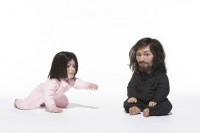JOHN WATERS
جون ووترز
约翰·沃特斯
존 워터스
ג’ון ווטרס
ジョン·ウォーターズ
Джон Уотерс
source: guardiancouk
John Waters on John Jr, one of the works in his Rear Projection exhibition: “This is the childhood portrait my parents had of me in their home growing up and I now have in my house. I remember posing for this picture and I was nuts then. But I was just figuring it out and I didn’t really mind being nuts, and so I wanted to remember that. That moustache of course I didn’t have at nine-years-old but I should have. In my mind it was festering.”
.
.
.
.
.
.
.
source: artinamericamagazine
NEW YORK Director John Waters’s ascent from notorious creator of Pink Flamingos (1972) to toast of Broadway is as instructive a lesson in the meshing of high and low American culture as is his film Pecker (1998), a cautionary fable—set in the art world—of redemption. His connoisseurship of vulgar Americana is rooted in Baltimore, his beloved hometown, which he depicts in that film as a vibrant, pansexual utopia.
Waters is a parodist. His first great subject was the average American family, and his second great subject is the art made in the period of his gallery debut. In 1995, being an artist looked mighty easy, especially from the perspective of the relaxed esthetic at the Colin de Land stable, which, when Waters joined it, included Cady Noland, Daniel Faust and Jessica Diamond. While the physical scale of Waters’s work has expanded since then, along with the art scene, little else has changed in his sensibility. “Rear Projection,” at Marianne Boesky, was a densely installed exhibition of photo-assemblages, text/image pieces and sculpture (all 2008 or ’09). Its many quotations include Allan McCollum’s enlargements of the background “art” in films and John Baldessari’s groupings from the mid-1970s of color images grabbed off video. Waters’s sequences of modestly scaled images, all culled from Hollywood films, bespeak the amateurism of the obsessed fan, an obsession that intersects with the less benign fixations of Larry Clark, Waters’s dark twin. Pieces like Santa Molester (a Santa stalking an anxious child), Look Out (tumbling car-crash victims) and Children Who Smoke (child actors puffing away) best reflect a camp sensibility happily mired in adolescence.
Occasionally, Waters drifts into welcome adult territory. With John Jr., he adds his signature pencil-thin mustache to a photograph of a pastel portrait of him as boy, commissioned locally by his parents. The single line across his delicate features transforms the youth of the mid-1950s to the John Waters action figure of the present, a defacement that echoes the gender-bending mustache and goatee of Duchamp’s L.H.O.O.Q. In Waters’s carefully executed mixed-medium sculpture Control, a spiffily dressed and coifed ’60s-era black man manipulates a marionette of a curvaceous black woman wearing a fur coat. It played nicely against the background of strolling collectors making discreet inquiries at the desk about prices—a scene that could be lifted directly from Pecker.
Waters looks at the archive of our cinematic unconscious through a warped lens of post-beatnik “sick” humor which, even when it wears thin—as it sometimes does at Boesky—remains authentic, if not visionary. I’m happy that it was Waters’s Hairspray that made it to the musical stage rather than Larry Clark’s Kids.
.
.
.
.
.
.
.
source: usmacmillan
John Waters is an American filmmaker, actor, writer, and visual artist best known for his cult films, including Hairspray, Pink Flamingos, and Cecil B. DeMented. He lives in Baltimore, Maryland.
.
.
.
.
.
.
.
source: baikebaidu
美国电影制片人、导演、演员、脱口秀表演者、作家、视觉艺术家、艺术品收藏家,因70年代拍摄的一系列Cult电影的而声名鹊起。沃特斯二十世纪70、80年代创作的“垃圾电影”都由他的固定演员班底“Dreamlander”完成,成员包括Divine,Mink Stole,David Lochary,Mary Vivian Pearce和Edith Massey。从1977年的 《绝望生活》开始,沃特斯开始选择真实生活中的罪犯和名声狼藉的人来拍摄电影。1988年的《发胶》是他第一部被主流电影界接受的电影。“垃圾教皇”、“恶心之王”、“恶趣味之父”,这些名号成为约翰·沃特斯电影艺术行为的诠释。
.
.
.
.
.
.
.
source: pitgamnet
החיים זה כלום אם אתה לא אובססיבי. אם אתה אאוטסיידר, ברגע שתפסיק להיות לחוץ לגבי זה, ותאמין שזה יתרון, אתה תנצח. על זה הסרטים שלי. תגזים את הדברים שמציקים לך עליהם ותהיה גאה בהם, ואז אנשים יכבדו אותך. התחבר עם הנוירוזות שלך: זוהי בגרות מודרנית.
– ג’ון ווטרס


